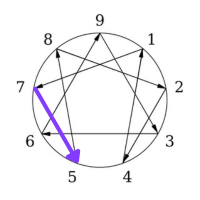Read time: 12 minutes | Core wound: Believing resources are scarce and the world is depleting
The child discovers early that the world is too much. Too loud. Too demanding. Too unpredictable. Too invasive. So they retreat—not physically, but mentally—into a fortress of their own making where knowledge becomes armor and understanding becomes power.
This is the birth of the Type 5, “The Observer.” In that formative moment when the world’s chaos threatened to overwhelm them, they made a life-defining decision: if you can’t control the external world, you can master the internal one. If you can’t stop people from invading your space, you can create an impenetrable mental sanctuary.
And so begins a lifetime of careful observation from protected distances, gathering knowledge like a survivalist hoards supplies, convinced that understanding equals safety and competence equals freedom.
The Fortress Mind
Type 5s don’t just think differently—they’ve constructed an entire mental architecture designed to protect them from a world they experience as depleting and invasive.
Watch a Five in a social situation. While others engage directly, they position themselves at the periphery—close enough to observe, far enough to escape. Their eyes track patterns others miss. Their mind catalogs information others ignore. They’re not being antisocial; they’re being strategic.
This isn’t shyness. It’s conservation. Type 5s operate from a core belief that their resources—energy, time, attention—exist in limited supply. Every interaction is a withdrawal from a finite account. Every commitment is a potential drain. Every expectation is a threat to their carefully maintained reserves.
The Scarcity Economy
At the heart of every Five runs an economy of scarcity. Not of money (though they’re often frugal), but of personal resources.
They wake each morning with a specific amount of energy for human interaction. Use it up, and they’re done—not angry, not sad, just empty. Like a phone battery that’s hit zero, they simply shut down until they can recharge in solitude.
This creates a peculiar relationship with the world. Fives often feel like they’re living in a foreign country where everyone else knows the language and customs, while they’re constantly translating, constantly effortful, constantly aware of how much energy each translation costs.
Wing Influences: Type 5s are influenced by their neighboring types. With a Type 4 wing (5w4), they become more creative and emotionally intense, combining deep analysis with artistic expression. With a Type 6 wing (5w6), they become more practical and security-oriented, focusing their knowledge toward building reliable systems and alliances.
| Type | Characteristic role | Ego fixation | Holy idea | Trap | Basic fear | Basic desire | Temptation | Vice/Passion | Virtue | Stress/Disintegration | Security/Integration |
|---|---|---|---|---|---|---|---|---|---|---|---|
| 5 | Investigator, Observer | Stinginess | Omniscience, Transparency | Observer | Helplessness, incapability, incompetence | Mastery, understanding | Replacing direct experience with concepts | Avarice | Detachment | 7 | 8 |
The Knowledge Sanctuary
For Type 5s, knowledge isn’t just interesting—it’s existential.
Their relationship with information resembles a medieval monk’s relationship with God: devoted, consuming, salvific. They don’t just learn; they excavate. They don’t just understand; they master. Each piece of knowledge is another stone in their fortress wall, another defense against a world that might otherwise overwhelm them.
The Observer’s Paradox
Fives live with a fundamental paradox: they hunger for understanding of life while holding themselves apart from living it.
They’re like marine biologists who study the ocean from a submarine—gathering incredible insights about underwater life while never getting wet. They can tell you everything about how relationships work while struggling to maintain one. They understand emotions intellectually while finding them baffling experientially.
This isn’t hypocrisy. It’s protection. Direct experience feels dangerous to Fives because it can’t be controlled, predicted, or paused for analysis. Knowledge, on the other hand, can be gathered safely from books, observations, and careful study.
Strengths of the Fortress
When Fives are at their best, they become:
Insight architects. They don’t just see facts—they see patterns, connections, and implications others miss entirely.
Innovation engines. Their willingness to question everything, including basic assumptions, leads to breakthrough discoveries.
Crisis stabilizers. When others panic, Fives detach and analyze, providing crucial objectivity in emotional storms.
Knowledge bridges. They can translate complex concepts into understandable frameworks, making the incomprehensible accessible.
The Cost of Distance
But fortresses, no matter how well-constructed, are still prisons.
The same boundaries that protect Type 5s also isolate them. The same detachment that provides objectivity also prevents intimacy. The same conservation that ensures resources also limits experience.
Their protective patterns manifest as:
Analysis paralysis. In trying to understand everything before acting, they may never act at all.
Emotional arctic. Feelings get frozen into concepts, analyzed rather than felt, creating an inner ice age where nothing grows.
Withholding patterns. They hoard not just knowledge but themselves—their thoughts, feelings, presence—creating scarcity in relationships.
Competence obsession. The fear of being unprepared can trap them in perpetual preparation, always learning but never applying.
When the Fortress Crumbles: Fives Under Stress
When overwhelmed, something shocking happens to the usually controlled Five. They shift toward the unhealthy aspects of Type 7, “The Enthusiast”—their careful mental architecture collapsing into chaos.

The transformation is jarring. The person who usually thinks before speaking suddenly can’t stop talking. The one who carefully conserves energy frantically pursues multiple activities. The strategic withdrawer becomes desperately social.
The Stress Spiral
- Overwhelm breaches their defenses
- Mental organization fragments
- Desperate attempts at escape through distraction
- Scattered thinking replaces focused analysis
- Impulsive action replaces careful planning
- Energy depletes rapidly
- Eventual collapse and forced withdrawal
This isn’t random. When their primary defense (withdrawal and analysis) fails, Fives swing to its opposite—trying to escape through expansion rather than contraction. But without their usual careful structure, this expansion becomes chaos.
Read more about other types under stress
The Childhood Blueprint
Every Five’s story begins with invasion.
Maybe it was a chaotic household where privacy didn’t exist. Maybe it was emotional demands they couldn’t meet. Maybe it was expectations that exceeded their resources. Whatever the specifics, young Fives learned that the world takes more than it gives.
The lesson crystallized: survival requires sanctuary.
So they built one—inside their own minds. They discovered that while people could invade their room, no one could invade their thoughts. While others could demand their presence, no one could demand their essence. While the external world remained uncontrollable, the internal world could be sovereign territory.
The Three Sanctuaries
Not all Fives build the same fortress:
Self-Preservation Fives create physical and resource sanctuaries. They’re the minimalists, the preppers, the ones who reduce needs to reduce vulnerability.
Sexual Fives seek sanctuary in one perfect connection. They’re the ones who share their inner world with a chosen few, creating intimacy through shared understanding.
Social Fives find sanctuary in expertise. They’re the specialists whose knowledge grants them a secure place in the social order.
Relationships: The Drawbridge Dilemma
For Fives, relationships present a fundamental challenge: how do you connect while maintaining necessary boundaries? How do you love without being consumed?
The Five’s Relationship Pattern
- Long observation phase: Studying the person from safe distance
- Gradual approach: Testing boundaries and compatibility
- Selective revelation: Sharing carefully chosen aspects
- Compartmentalization: Maintaining separate spaces
- Withdrawal cycles: Regular retreats to recharge
Many Fives describe relationships like operating a drawbridge—carefully lowering it to allow someone across the moat, always maintaining the ability to raise it when overwhelmed.
What Fives Need in Love
A partner who understands silence. Someone who doesn’t interpret withdrawal as rejection but as necessary recharging.
Respect for boundaries. Clear agreements about space, time, and energy that don’t require constant renegotiation.
Intellectual connection. Shared curiosity and the ability to explore ideas together without emotional drama.
For Partners of Fives
Don’t take their need for space personally. It’s not about you—it’s about them maintaining the internal equilibrium necessary for them to function.
When they share something personal, recognize it as the gift it is. They’re literally giving you a piece of their carefully guarded inner world.
Learn to appreciate their unique expressions of love: remembering something you mentioned once, researching solutions to your problems, being steadfastly present in crisis.
Learn more about other types in relationships and explore the Enneagram compatibility matrix to understand how Type 5s connect with each type.
The Path to Integration: From Hoarding to Sharing
The Five’s growth journey isn’t about abandoning their fortress. It’s about installing windows and doors—creating openings that allow flow while maintaining structure.
Moving Toward Eight
When Fives integrate, they move toward the healthy aspects of Type 8, “The Challenger.” This doesn’t mean becoming aggressive or domineering. It means discovering that knowledge without action is impotent, that understanding without application is incomplete.
Integrated Fives learn to:
- Trust their competence enough to engage before feeling perfectly prepared
- Express themselves assertively rather than withdrawing
- Take up space in the world rather than minimizing their presence
- Connect knowledge to power, using understanding to create impact
Practical Steps for Growth
The Engagement Experiment
Choose one area where you have theoretical knowledge but little experience. Engage directly. Notice that imperfect action teaches more than perfect theory.
The Feeling Practice
Set a timer three times daily. When it goes off, ask: “What am I feeling right now?” Don’t analyze it—just feel it.
The Generosity Challenge
Share one piece of knowledge daily without being asked. Notice that giving doesn’t deplete but often energizes.
The Presence Practice
In conversations, resist the urge to retreat into your mind. Stay present with the person, not just their ideas.
The Ultimate Discovery
The most integrated Fives discover a profound truth: engaging with life doesn’t deplete resources—it generates them. Connection doesn’t drain—it energizes. Sharing knowledge doesn’t diminish their value—it multiplies their impact.
The fortress that protected them in childhood becomes a prison in adulthood. But they don’t need to demolish it. They need to transform it from a bunker into a lighthouse—still elevated, still protected, but now illuminating the world rather than hiding from it.

Personal Growth by Type
Voices from the Fortress: Fives Speak
Type 5s rarely speak publicly about their inner experience, but when they do they usually say the following:
On their inner world: “People see quietness and assume emptiness. They don’t realize I’m running a complex operation in here—analyzing, connecting, understanding. My mind never stops.”
On relationships: “I want connection desperately, but it’s like speaking a foreign language. I can study it, understand its grammar, but fluency requires immersion I find exhausting.”
On energy: “Imagine starting each day with exactly ten coins. Every interaction costs one. Some people cost two. By noon, I’m often bankrupt.”
On growth: “Learning that engagement generates energy rather than depletes it was revolutionary. But I had to experience it to believe it—knowledge wasn’t enough.”
🤝 The Observer’s Testimony: Type 5s Share Their Experience
The theoretical architecture of Type 5 comes alive through firsthand accounts. In panel discussions and interviews, Type 5s offer rare glimpses into their internal experience:
🌟 Famous Enneagram 5s
- Agatha Christie
- Andrew Huberman
- Bill Gates
- Cillian Murphy
- David Sacks
- Elon Musk
- Friedrich Nietzsche
- George RR Martin
- Jack Dorsey
- Lex Fridman
- Malcolm Gladwell
- Mark Zuckerberg
- PewDiePie
- Robert Greene
- Rooney Mara
- Tina Fey
Daniel Day Lewis
John Lennon
Leonardo da Vinci
Stephen King
Tyler Cowen
Zach King